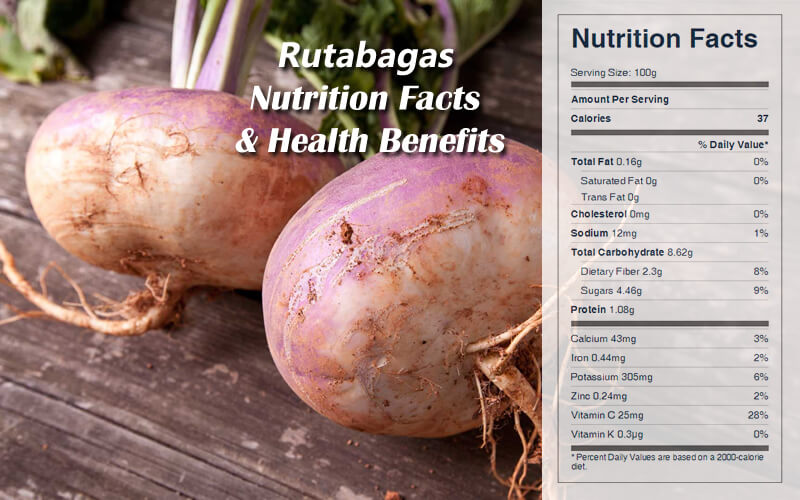Rutabagas Nutrition Facts & Health Benefits
Rutabaga is a health-giving root vegetable that belongs to the crucifer family. It’s an excellent vegetable. Rutabaga roots are eaten as human food in a variety of ways, and the leaves can be eaten as a leaf vegetable. Here are the nutritional benefits of rutabagas.
Nutritional Value 0f Rutabaga
One-half cup of boiled rutabaga cubes provides 33 calories, 7.4 g carbohydrate, 1.1 g protein, 0.2 g fat, 1.5 g dietary fiber, 477 IU vitamin A, 16 mg vitamin C, 13 mcg folic acid, 277 mg potassium, 17 mg sodium, 48 mg phosphorus, 41 mg calcium, and 20 mg magnesium.

Rutabagas Nutrition Facts Label
Health Benefits of Rutabagas
Rutabaga is a kind of root vegetable, a hybrid between the cabbage and the turnip. It belongs to the cruciferous vegetables and has all the anti-cancer properties of this family of plants. They are also known as Swedish turnips or yellow turnips. Rutabaga roots are eaten as human food in a variety of ways, and the leaves can be eaten as a leaf vegetable.
Rutabaga contains protective phytochemicals and significant amounts of vitamin C; almost no sodium; a little fiber; small amounts of trace minerals, and a good source of potassium. They are also high in fiber. They are a good source of beta-carotene and also contain some vitamin C, B-complex vitamins, calcium, potassium, fiber, and carbohydrates. It has only 24 calories per serving but lots of satisfying bulk, making it a real bonus for those watching their weight.
Cooked rutabagas are somewhere in between our starchy vegetable and true vegetable categories. But they can also be eaten raw, which preserves more of their vitamins A and C, so try them in thin slices as an addition to salads.
Like other members of the cruciferous family, rutabagas are rich in antioxidant dithiolthiones, sulfur, and indoles, which have anti-cancer activity. Rutabaga stimulates the liver and is recommended in treatments for constipation, digestive disorders, and intestinal worms.
Rutabagas are loaded with phytochemicals, including carotenoids, terpenes, flavonoids, coumarins, indoles, phenolic acids, and isothiocyanates. Many of these chemicals are believed to act as antioxidants and cancer fighters; they may also help preserve vision and lower blood pressure.
Mashed together with potatoes, rutabagas produce an interesting and tasty variation on the usual dish and are an excellent early weaning food for babies.
In the US, rutabagas are not widely eaten, but may be found as part of stews or casseroles, served mashed with carrots, or baked in a pasty.
Health Risk
Note that, like other cruciferae, rutabagas contain goiterogens and should be eaten in moderation by anyone with thyroid problems or taking long-term thyroxin treatment.
Rutabaga and other cyanoglucoside-containing foods (including cassava, corn, bamboo shoots, sweet potatoes, and lima beans) release cyanide, which is subsequently detoxified into thiocyanate. At high doses, thiocyanate inhibits thyroid iodide transport and, at low doses, competes with iodide in the organification process within thyroid tissue. Goitres may develop when there is a dietary imbalance of thiocyanate-containing foods in excess of iodine consumption, and it is possible for these compounds to contribute to hypothyroidism.
As with watercress, mustard greens, turnips, broccoli, and horseradish, the perception of bitterness in rutabaga is governed by a gene affecting the TAS2R bitter receptor, which detects the glucosinolates in rutabaga. Sensitive individuals with the genotype PAV/PAV (supertasters) find rutabaga twice as bitter as insensitive subjects (AVI/AVI). As a result, sensitive individuals may find some rutabagas too bitter to eat.